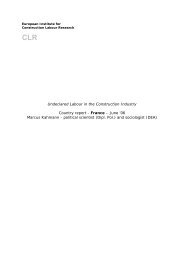Japan – what can we learn? - Construction Labour Research
Japan – what can we learn? - Construction Labour Research
Japan – what can we learn? - Construction Labour Research
Create successful ePaper yourself
Turn your PDF publications into a flip-book with our unique Google optimized e-Paper software.
policy <strong>we</strong>re Toyota, Nissan, Canon, Matsushita, etc. Due to theconfusion of the trade cycle and structural change, the economicpolicy resulted in a monetary easing, massive influx of exportingexpenses into the domestic market, and expansion of financialexpenditure. These conditions caused the rise in land values as <strong>we</strong>ll asstock prices, and ended up with the economic bubble. Theconstruction industry also enjoyed a huge amount of orders thanks tothe boom in the core industries. During these five years (from1986 to1991), construction investment increased by 53.7 percent, from 53.6trillion to 82.4 trillion. 1992 marked the investment peak, with thebeginning of the collapse of the bubble economy.- The second stage ran from 1992 to 1998. Private investment beganto decrease in 1992. It had continuously been downscaling for fouryears until 1995. In 1996, it sho<strong>we</strong>d a slight reverse, but it againturned to a decrease from 1997 to 2004. This long cutback in privateinvestment caused the recession with a breakdown in land and stockspeculation, and a banking crisis. In order to handle these problems,public investment sho<strong>we</strong>d the opposite trend during this period. Thegovernment poured in large amounts of financial funds, up to 35trillion yen, as a conventional practice for any economic recoverypolicy. This policy was not simply meant as a measure to boost theeconomy. It was grounded in a treaty with the U.S., the decade-longsocial investment plan that amounted to 630 trillion yen. This policyformed the largest construction market in <strong>Japan</strong>ese history (84 trillionyen in 1992). The economic policy of that period inherited theprevious deviation to large companies. When interpreted favourably,the government was afraid of an economic crash, that if it economisedin terms of construction investment, the banking institutes related toZaibatsu would get into trouble with bad debt and uncollectible loansfor construction projects. As those banking institutes also take the roleof a central nervous system for large companies, government fearedscale expansion as a financial remedy. The treaty with the U.S.provided the legitimate basis for enlarging investment.- The third stage is from 1999 to 2004. From 1999 public investmentfinally began to decrease along with private investment. It was thebeginning of full-scale reduction in the market. Compared to the peakof 84.0 trillion in 1992, investment was cut back to 53.2 trillion, andCLR News No 2/200620









